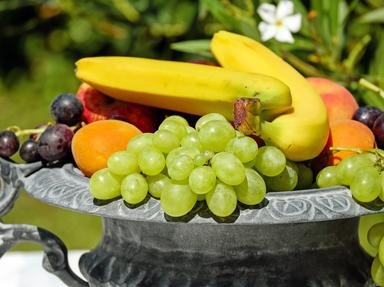Quiz Answer Key and Fun Facts
1. Citrus fruits are nutritious and popular for eating and for juices and drinks like lemonade. But there is actually a citrus tree called a "lemonade tree"! Where did growers develop this sweet cross between a lemon and a mandarin orange?
2. Used as a symbol in the Qur'an, Christian iconography, Greek and other Mediterranean and Middle Eastern mythologies, as well as the Hebrew Scriptures, what fruit eaten on Rosh Hashanah is said to have 613 seeds, one for each of the commandments of the Torah?
3. One of the original citrus fruits, citrus medica is mostly used for its inner rind, which is preserved in sugar and is familiar to many people today as that brightly-dyed sweet stuff in fruitcake and plum pudding. One variety is called the Buddha's hand, for its long finger-like tendrils, and another is the etrog, which is carried along with a branch of leaves called the lulav in the Jewish festival called Sukkot. What is this ancient fruit called?
4. If you want a really good apple, you should grow a tree from the seeds of a particularly delicious apple and wait for it to produce the same sort of fruit.
5. Although the Concord, developed from wild grapes in Massachusetts, is perhaps the best known cultivar of North American grapes, what variety was first seen by Englishmen on Roanoke Island in 1584, where the "Mother Vine" can still be found?
6. What fruit grows in bogs on an evergreen dwarf shrub, is high in antioxidants, and is often made into juice or a jellied sauce served at Thanksgiving meals in the United States and Canada?
7. In the Domesday Book of 1086, what kind of fruit trees were used as boundary markers in England?
8. On which continent did David Livingstone find huge numbers of watermelons growing wild, settling the question of its origins?
9. Apricots and plums are important commercially as dried fruit, as are grapes, dates, and figs. Until advertising campaigns of the 21st century sought to make them more appealing by referring to them as dried plums, which they literally are, what were dried plums usually called?
10. Okay, most of us learned in childhood that the tomato is not a true vegetable but a fruit, specifically a berry. We also know that for around 200 years after first contact Europeans thought the tomato was poison. Other than fears caused by its classification in the deadly nightshade family and other "scientific" propaganda against it, what did the tomato's high acid react with to cause some people to conclude that tomatoes themselves were poisonous?
Source: Author
nannywoo
This quiz was reviewed by FunTrivia editor
WesleyCrusher before going online.
Any errors found in FunTrivia content are routinely corrected through our feedback system.

